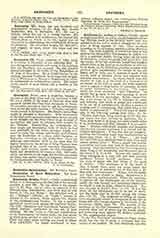

Anathema (Gr. anathema, or anthema, literally placed on high, suspended, set aside), a term formerly indicating offerings made to the divinity which were suspended from the roof or walls of temples for the purpose of being exposed to view. Thus anathema according to its etymology signifies a thing offered to God. The word anathema is sometimes used in this sense in the Old and New Testaments: In Judith, xvi, 23, it is said that Judith, having taken all the arms of Holofernes which the people had given him, and the curtain of his bed which she herself had brought, offered them to the Lord as an anathema of oblivion. In II Mach., ix, 16, Antiochus promises to adorn with precious gifts (anathemata) the temple he has pillaged; and in Luke, xxi, 5, mention is made of the temple built of precious stones and adorned with rich gifts (anathemata). As odious objects were also exposed to view, e.g. the head of a criminal or of an enemy, or his arms or spoils, the word anathema came to signify a thing hated, or execrable, devoted to public abhorrence or destruction. “To understand the word anathema”, says Vigouroux, “we should first go back to the real meaning of herem of which it is the equivalent. Herem comes from the word haram, to cut off, to separate, to curse, and indicates that which is cursed and condemned to be cut off or exterminated, whether a person or a thing, and in consequence, that which man is forbidden to make use of.” This is the sense of anathema in the following passage from Deut., vii, 26: “Neither shalt thou bring anything of the idol into thy house, lest thou become an anathema like it. Thou shalt detest it as dung, and shalt utterly abhor it as uncleanness and filth, because it is an anathema.” Nations, individuals, animals, and inanimate objects may become anathema, i.e. cursed and devoted to destruction. It was thus that the people inhabiting the Promised Land were anathematized as Moses says (Deut., vii, 1, 2): “When… the Lord thy God shall have delivered them to thee, thou shalt utterly destroy them.” When a people was anathematized by the Lord, they were to be entirely exterminated. Saul was rejected by God for having spared Agag, King of the Amalecites, and the greater part of the booty (I K. xv, 9-23). Anyone who spared anything belonging to a man who had been declared anathema, became himself anathema. There is the story of Achan who had charge of the spoils of Jericho: “The anathema is in the midst of thee, O Israel: thou canst not stand before thy enemies till he be destroyed out of thee that is defiled with this wickedness.” Achan, with his family and herds, was stoned to death. Sometimes it is cities that are anathematized. When the anathema is rigorous all the inhabitants are to be exterminated, the city burned, and permission denied ever to rebuild it, and its riches offered to Jehovah. This was the fate of Jericho (Jos., vi, 17). If it is less strict, all the inhabitants are to be put to death, but the herds may be divided among the victors (Jos., viii, 27). The obligation of killing all inhabitants occasionally admits of exceptions in the case of young girls who remain captives in the hands of the conquerors (Num., xxxi, 18). The severity of the anathema in the Old Testament is explained by the necessity there was of preserving the Jewish people and protecting them against the idolatry professed by the neighboring pagans.
In the New Testament anathema no longer entails death, but the loss of goods or exclusion from the society of the faithful. St. Paul frequently uses this word in the latter sense. In the Epistle to the Romans (ix, 3) he says: “For I wished myself to be an anathema from Christ, for my brethren, who are my kinsmen according to the flesh”, i.e. “I should wish to be separated and rejected of Christ, if by that means I would procure the salvation of my brethren.” And again, using the word in the same sense, he says (Gal. i, 9): “If any one preach to you a gospel besides that which you have received, let him be anathema.” But he who is separated from God is united to the devil, which explains why St. Paul, instead of anathematizing, sometimes delivers a person over to Satan (I Tim., i, 20; I Cor., v, 5). Anathema signifies also to be overwhelmed with maledictions, as in I Cor., xvi, 22: “If any man love not our Lord Jesus Christ, let him be anathema.” At an early date the Church adopted the word anathema to signify the exclusion of a sinner from the society of the faithful; but the anathema was pronounced chiefly against heretics. All the councils, from the Council of Nicaea to that of the Vatican, have worded their dogmatic canons: “If any one says. let him be anathema”. Nevertheless, although during the first centuries the anathema did not seem to differ from the sentence of excommunication, beginning with the sixth century a distinction was made between the two. A Council of Tours desires that after three warnings there be recited in chorus Psalm cviii against the usurper of the goods of the Church, that he may fall into the curse of Judas, and “that he may die not only excommunicated, but anathematized, and that he may be stricken by the sword of Heaven“. This distinction was introduced into the canons of the Church, as is proved by the letter of John VIII (872-82) found in the Decree of Gratian, (c. III, q. V, c. XII): “Know that Engeltrude is not only under the ban of excommunication, which separates her from the society of the brethren, but under the anathema, which separates from the body of Christ, which is the Church.” This distinction is found in the earliest Decretals, in the chapter Cum non ab homine. In the same chapter, the tenth of Decretals II, tit. i, Celestine III (1191-98), speaking of the measures it is necessary to take in proceeding against a cleric guilty of theft, homicide, perjury, or other crimes, says: “If, after having been deposed from office, he is incorrigible, he should first be excommunicated; but if he perseveres in his contumacy he should be stricken with the sword of anathema; but if plunging to the depths of the abyss, he reaches the point where he despises these penalties, he should be given over to the secular arm.” At a late period, Gregory IX (1227-41), bk. V, tit. xxxix, ch. lix, Si quem, distinguishes minor excommunication, or that implying exclusion only from the sacraments, from major excommunication, implying exclusion from the society of the faithful. He declares that it is major excommunication which is meant in all texts in which mention is made of excommunication. Since that time there has been no difference between major excommunication and anathema, except the greater or less degree of ceremony in pronouncing the sentence of excommunication.
Anathema remains a major excommunication which is to be promulgated with great solemnity. A formula for this ceremony was drawn up by Pope Zachary (741-52) in the chapter Debent duodecim sacerdotes, Cause xi, quest. iii. The Roman Pontifical reproduces it in the chapter Ordo excommunicandi et absolvendi, distinguishing three sorts of excommunication: minor excommunication, formerly incurred by a person holding communication with anyone under the ban of excommunication; major excommunication, pronounced by the Pope in reading a sentence; and anathema, or the penalty incurred by crimes of the gravest order, and solemnly promulgated by the Pope. In passing this sentence, the pontiff is vested in amice, stole, and a violet cope, wearing his mitre, and assisted by twelve priests clad in their surplices and holding lighted candles. He takes his seat in front of the altar or in some other suitable place, and pronounces the formula of anathema which ends with these words: “Wherefore in the name of God the All-powerful, Father, Son, and Holy Ghost, of the Blessed Peter, Prince of the Apostles, and of all the Saints, in virtue of the power which has been given us of binding and loosing in Heaven and on earth, we deprive N—himself and all his accomplices and all his abettors of the Communion of the Body and Blood of Our Lord, we separate him from the society of all Christians, we exclude him from the bosom of our Holy Mother the Church in Heaven and on earth, we declare him excommunicated and anathematized and we judge him condemned to eternal fire with Satan and his angels and all the reprobate, so long as he will not burst the fetters of the demon, do penance and satisfy the Church; we deliver him to Satan to mortify his body, that his soul may be saved on the day of judgment.” Whereupon all the assistants respond: “Fiat, fiat, fiat.” The pontiff and the twelve priests then cast to the ground the lighted candles they have been carrying, and notice is sent in writing to the priests and neighboring bishops of the name of the one who has been excommunicated and the cause of his excommunication, in order that they may have no communication with him. Although he is delivered to Satan and his angels, he can still, and is even bound to repent. The Pontifical gives the form for absolving him and reconciling him with the Church. The promulgation of the anathema with such solemnity is well calculated to strike terror to the criminal and bring him to a state of repentance, especially if the Church adds to it the ceremony of the Maranatha.
At the end of the first Epistle to the Corinthians, xvi, 22, St. Paul says, “If any man love not our Lord Jesus Christ, let him be anathema, maranatha,” which means, “The Lord is come.” But commentators have regarded this expression as a formula of excommunication very severe among the Jews. This opinion, however, is not sustained by Vigouroux, “Dict. de la Bible” (s.v. Anatheme). In the Western Church, Maranatha has become a very solemn formula as anathema, by which the criminal is excommunicated, abandoned to the judgment of God, and rejected from the bosom of the Church until the coming of the Lord. An example of such an anathema is found in these words of Pope Silverius (536-38): “If anyone henceforth deceives a bishop in such a manner, let him be anathema maranatha before God and his holy angels.” Benedict XIV (1740-58—De Synodo dicecesana X, i) cites the anathema maranatha formulated by the Fathers of the Fourth Council of Toledo against those who were guilty of the crime of high treason: “He who dares to despise our decision, let him be stricken with anathema maranatha, i.e. may he be damned at the coming of the Lord, may he have his place with Judas Iscariot, he and his companions. Amen.” There is frequent mention of this anathema maranatha in the Bulls of erection for abbeys and other establishments. Still the anathema maranatha is a censure from which the criminal may be absolved; although he is delivered to Satan and his angels, the Church, in virtue of the Power of the Keys, can receive him once more into the communion of the faithful. More than that, it is with this purpose in view that she takes such rigorous measures against him, in order that by the mortification of his body his soul may be saved on the last day. The Church, animated by the spirit of God, does not wish the death of the sinner, but rather that he be converted and live. This explains why the most severe and terrifying formulas of excommunication, containing all the rigors of the Maranatha have, as a rule, clauses like this: Unless he becomes repentant, or gives satisfaction, or is corrected.
JOSEPH N. GIGNAC


